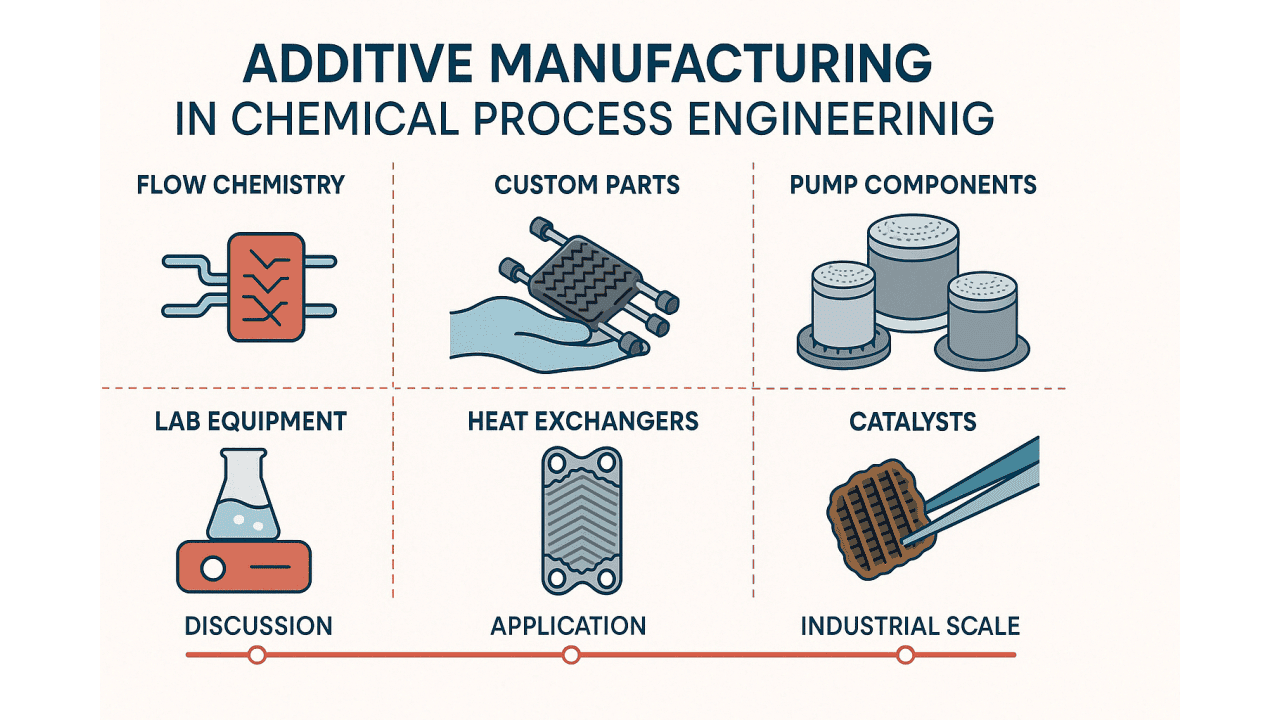Additive Manufacturing in Chemical Process Engineering – Status, Potential and Outlook
Additive manufacturing is widely used in chemical process engineering—and drives innovation. Yet despite its adoption across the industry, the landscape remains fragmented. This white paper offers a brief overview.
Ten years ago, additive manufacturing (AM) - then often referred to simply as 3D printing- was hailed as “the next industrial revolution” in trade media and expert community within the chemical and process industries. Predictions included a complete restructuring of supply chains, with spare parts produced on-site rather than shipped globally, and the emergence of entirely new process concepts based on on-demand, individualized component fabrication.
Today, AM technologies are significantly more mature, and a wide range of materials is available. While AM has not achieved the widespread adoption once predicted, it has become a door-opener for innovations that are otherwise difficult to realize. The idea of a “silent revolution” is, once again, a fitting description.
A standard tool for customized solutions in the laboratory
In laboratory environments, 3D printing has long since become an indispensable tool—especially when bespoke solutions are needed. Custom-built mini reactors, stirrers, and even centrifuges are now part of everyday operations in many research institutions and are routinely produced using additive manufacturing. Adapters and components for analytical equipment are also frequently printed in-house.
AM enables the production of devices and parts that are either unavailable as commercial off-the-shelf items or uneconomical to procure due to low quantities. It also helps bridge supply gaps caused by uncertain or disrupted supply chains.
While academic labs were early adopters of AM, the technology has since gained a foothold in mainstream chemical process engineering. Manufacturers of geometrically complex components—such as stirrers and mixers—have embraced 3D printing with both polymers and metal alloys. The pump manufacturer KSB, for example, has built its own in-house 3D printing expertise over the years and now produces both custom components and replacement parts. The company views AM as a valuable complement to traditional manufacturing methods.
Building In-House Expertise: Engineering Units Take the Lead
Large chemical companies are increasingly investing in internal AM expertise. BASF, for instance, established a dedicated additive manufacturing unit in 2015 within its Global Engineering Services division. The focus lies on producing components for in-house use particularly when AM offers improved performance, greater process efficiency, or ensures operational availability. The unit specializes in metal-based components, including static mixers, heat exchangers, and compressors. As a result, AM has become a strategic element in BASF’s maintenance approach.
Shell likewise employs AM for spare parts as well as in the prototyping and development of new components. The company is actively developing its own in-house know-how. Printed parts range from simple clamps to complex, novel catalyst geometries.
Evonik has also centralized its AM efforts in a dedicated competence centre, where prototypes for simulations are the primary output. However, the company also sees great potential in modular plant concepts. These modular systems consist of standardized, functional units that can be flexibly combined depending on their intended use. Each module includes its own “intelligence,” with standardized interfaces and data formats enabling seamless plug-and-play operation.
AM as an Innovation Driver
In some areas of chemical process engineering, additive manufacturing does more than improve existing solutions It is the key to innovation itself. One such area is flow chemistry, where traditional batch processes are being replaced by continuous operations. This shift enables comparable production volumes with significantly smaller reactor sizes and allows for much more efficient control of parameters such as heat transfer.
The intricate geometries required for milli- and microfluidic reactors are a perfect match for AM technologies. Conventional manufacturing methods struggle to achieve such complexity, especially at scale, making AM an ideal enabler for serial production in this domain.
Many applications in process engineering demand maximum surface area within minimal space—for instance, in catalyst supports or adsorption processes. Here, features like pore size and internal architecture are critical. Components made using conventional processes such as sintering tend to be heavy and bulky. AM, by contrast, allows for compact, lightweight components with precisely defined internal structures.
In catalysis in particular, AM is unlocking new possibilities. It not only enables the fabrication of tailored support structures but also allows the catalytic material itself to be processed directly via 3D printing. BASF is leading the way with its X3D technology. The results: reduced energy consumption for gas flow and significantly higher conversion rates, thanks to the increased active surface area provided by AM-enhanced structures. Following a successful pilot phase, BASF plans to begin industrial-scale production of X3D-printed catalysts in 2026.
Remaining hurdles
Despite numerous proven applications and economically viable use cases, additive manufacturing still plays only a limited role as a cross-cutting technology in chemical process engineering. One reason may be the sheer diversity of use cases: varying scales, materials, and application areas often lead to high specialization and limited exchange between stakeholders. As a result, much of the expertise remains siloed within individual companies and departments—largely invisible to the broader market.
Another limiting factor is the lack of standardized, fast, and reliable workflows for the design and production of AM components. Costs remain relatively high compared to conventional manufacturing. Finally, certification requirements have long posed a barrier to widespread use in safety-critical environments—although many of these issues have now been largely resolved.
What’s Next?
Additive manufacturing has advanced significantly over the past decade. New materials—such as PU elastomers and photocatalytically cured polymers—have expanded the scope of applications, while printing technologies themselves have become markedly more sophisticated. Although many printed surfaces still require post-processing, the coarse structures of the early days are long gone.
The design freedom offered by AM is sparking creativity, particularly in reaction engineering and flow chemistry. Researchers are exploring entirely new geometries with organic, non-linear forms—shapes that would be unthinkable using conventional manufacturing.
Like in other industries, AM is moving beyond prototyping and increasingly entering laboratories, workshops, and pilot plants of chemical companies of all sizes. As scaling and standardization progress, its adoption will accelerate further.
A critical success factor moving forward is the early integration of AM into design and simulation processes. Rather than adapting conventionally designed components for additive manufacturing after the fact, companies should begin designing specifically for AM from the outset.
When researchers develop AM solutions to meet their own practical needs, it often leads to broader adoption. Such bottom-up innovation can unlock new potential for AM in established industrial processes—both technically and economically.
AM as a Catalyst and Enabler
Additive manufacturing holds immense potential to address key challenges in the chemical and process industries. Its role is particularly valuable in decentralized and modular production concepts, where it supports localized manufacturing and flexible plant scaling.
AM also drives efficiency—through miniaturization and through entirely new approaches to reactor and catalyst design. It is already accelerating the development and pilot implementation of Power-to-X systems, and in the future, it could play a key role in full-scale manufacturing processes.
To fully leverage this potential, stronger collaboration between stakeholders in process engineering and adjacent fields is essential. Additive manufacturing is only at the beginning of its journey in this domain—and the opportunities ahead are vast.
Have you identified applications in chemical process engineering or are you looking to exchange ideas with experts in the industry? Our authors Dr. Kathrin Rübbert, DECHEMA e.V. and Dr. Özlem Weiss, Expertants GmbH, look forward to your visit during rapid.tech 3D 2025!
Text: Authors | Infographic: Cleo (AI-generated, editorially reviewed)

